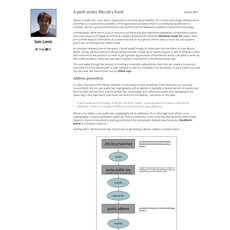Jameson Lopp Presentations Review
Jameson Lopp Presentations
lopp.net
Jameson Lopp Presentations review guide: everything you need to know + FAQ
Ever wished you could learn Bitcoin from someone who’s shipped code, run nodes, broken things on purpose, and then showed you how to fix them? What if there were a single page that lined up years of smart, no‑fluff Bitcoin talks with slides and videos you can watch tonight?
There is: Jameson Lopp Presentations. And if you want maximum signal with zero wandering through clickbait, you’re in the right place.
“Privacy is a process. Security is a practice.”
This guide shows you how to get the most from Jameson Lopp’s Presentations page—whether you’re just getting started, already running a node, or tightening your self‑custody and privacy. I’ll help you pick where to start, what to watch first, and how to turn those talks into real skills that protect your coins and sharpen your thinking.
Describe problems or pain
Finding high‑signal Bitcoin education without wasting hours is tough. You know the feeling:
- You open YouTube for a “quick” Bitcoin video and get lost for an hour. With around 500+ hours uploaded every minute, the odds of pure noise are high.
- Blog posts go out of date. Wallet UIs change. Good advice gets buried under hot takes and sponsored shills.
- You want practical, not hype: how to secure coins, run a node, avoid privacy leaks, and pick sane tradeoffs.
And the questions keep coming:
- Is Lopp’s stuff beginner‑friendly, or only for devs?
- Which talks actually matter right now?
- Are the slides available, or just video?
- How technical are the talks? Where should I start if my goal is simple: don’t lose coins, don’t leak data?
Here’s a relatable example. Say you want to run a node on a Raspberry Pi. You search around and hit ten different “ultimate” guides, each with different hardware lists, conflicting advice on pruning, and no clear threat model. One solid, experience‑backed talk could save you days of trial and error—and stop you from misconfiguring your backups or exposing your IP.
Promise solution
I’ve done the sorting for you. I mapped the Presentations page, grouped the best talks by skill level, flagged the must‑watch picks, and built a simple learning path so you can get value in the first hour—not the tenth. I’ll also answer the common “People Also Ask” questions (beginner‑friendly? slides? updates? how technical?) so you can spend your time learning, not hunting.
One more tip I’ll use throughout: research on dual coding suggests people learn better when they combine visuals with audio. That’s why I’ll show you how to use Lopp’s slides and videos together for faster, stickier learning.
What you’ll get from this guide
- Clear overview of the page and how it’s laid out
- Best starting points based on your goal and experience
- Quick pros/cons so you know what to expect
- How to use slides vs. videos for efficient study
- A simple 7‑day plan that turns talks into real‑world actions
- A practical FAQ with fast answers to the questions you’re likely asking
Expect zero fluff. If your goal is to protect keys, improve privacy, and actually understand how Bitcoin works in the real world, you’ll be right at home.
Who this is for
- Newcomers who want signal without the noise
- Self‑custody users who care about security and privacy
- Builders, node operators, and Bitcoin‑curious developers
- Anyone comparing Lopp’s work with other learning hubs
Ready to see what’s actually on the Jameson Lopp Presentations page and how it’s structured so you can pick your first talk in under a minute? Let’s open it up next and take a quick tour.
What is Jameson Lopp’s Presentations page?
If you want a clean, no-BS way to learn Bitcoin from someone who’s actually built and run things, bookmark this: Jameson Lopp Presentations. It’s a fast-loading list of talks with titles, dates, event names, and direct links to slides and videos when available. No ads. No paywalls. Just years of talks organized in a way that respects your time.
Why it exists is simple: to share practical lessons from the trenches—how to secure your coins, how Bitcoin actually works under pressure, and how to think clearly about decentralization and tradeoffs. It’s like a highlight reel from conference stages, distilled onto a single page.
Who is Jameson Lopp?
A long-time Bitcoin engineer and security obsessive who’s spent years hardening real setups, running nodes, and explaining complex ideas with clarity. He’s known for methodical research, operational best practices, and tools that help people be more sovereign. When he speaks, it’s not theory—it's field-tested insight.
“Privacy is a process, not a one-time switch.”
That mindset runs through his work: practical, honest, and focused on what you can do today.
What you’ll find on the page
Expect a range of talks that cover the most important corners of Bitcoin, typically with both slides and a video recording:
- Security & self-custody: threat modeling, backup strategies, passphrases, and ways to avoid lockouts or theft.
- Privacy: address reuse pitfalls, UTXO management, wallet hygiene, and realistic expectations for staying private.
- Running nodes: why running your own node matters, hardware options, network configuration, and uptime discipline.
- Metrics of decentralization: data on node counts, client diversity, mining pool concentration, and network health trends. Slides often link sources so you can verify the numbers yourself.
- Lightning & scaling: reliability, routing realities, and what scaling actually looks like in practice (not just Twitter takes).
- Bitcoin culture & resilience: incentives, survivability, and how to build systems that fail gracefully.
Real examples you’ll see on slides: a side-by-side of common backup setups (and how they break), charts tracking network participants over years, and checklists for safe wallet migrations. In data-heavy sessions, you’ll notice references to public datasets and open methodologies—so if you’re the “show me the receipts” type, you’re covered.
How it’s organized (and what that means for you)
The page lists talks by title and typically by year/event. That’s good news: you can quickly scan for relevance and freshness. Want privacy updates from the last couple of years? Scroll and eyeball the dates. Looking for foundational security habits? The core lessons hold up, so the year matters less.
- Use your browser’s Find (Ctrl/Cmd+F) for words like “privacy,” “node,” “Lightning,” or “decentralization.”
- Open the slides alongside the video. Many diagrams make concepts click at a glance.
- Watch the Q&A segments when available—that’s where edge cases and real-world gotchas show up.
Is it free and do you need an account?
It’s 100% free and open. No sign-in. Slides are usually direct links (often PDFs or web decks). Videos typically live on conference channels or YouTube/Vimeo. You can even save the slide decks for offline study and keep your own notes next to them.
I like resources that respect your time and your autonomy—this page does both. Now, the only real question is: with so many strong talks, where should you start so you don’t get overwhelmed? In the next section, I’ll map out simple paths—beginner, intermediate, and advanced—and give you a must-watch shortlist that delivers 80% of the value in a weekend. Ready to pick your path?
Where to start: my recommended paths
Opening Lopp’s presentations can feel like walking into a library that only stocks the good books. The trick is picking a path that matches your goal today, not “someday.” Here’s how I map it—beginner, intermediate, and advanced—so you learn fast and put it to work immediately.
“Security is a process, not a product.”
—Bruce Schneier
Beginner path: build strong foundations
If you’re new or just getting serious about self-custody, start with mindset and simple, repeatable habits. Look for talks with titles and themes like security survival, running a node, and privacy is a process. These give you the 80/20 of Bitcoin done right.
- What to click: Talks that explain why decentralization matters, the basics of protecting keys, how nodes work in plain language, and common mistakes to avoid.
- You’ll learn: Why self-custody beats custodial risk, what a seed phrase actually represents, how to think about backups, and why your own node changes your threat model.
- Do this after watching:
- Create a simple two-location backup plan (primary seed + offsite copy). Test a recovery on a spare device or test wallet.
- Turn on coin labeling in your wallet. Stop address reuse today—future you will thank you.
- Write a 1-page “setup doc” in plain language. If you can’t explain it, you don’t own it.
Why this works: cognitive research points to “first principles + immediate application” as the fastest way to lock in new skills. You’re not memorizing buzzwords—you’re changing habits.
Intermediate path: security, nodes, and privacy
Ready to go from safe to resilient? This is where you refine your setup and stop making costly errors. Aim for talks that compare self-custody tradeoffs, discuss node incentives and configurations, and explain privacy techniques and threat modeling.
- What to click: Sessions that unpack single-sig vs. multisig, air-gapped signing workflows, Tor-enabled wallets, node hardware options (Raspberry Pi vs. mini PC), pruning vs. archival decisions, and common privacy heuristics analysts use.
- Watch for: Slides with seed entropy charts, example attack trees, UTXO management visuals, and node topology diagrams. Lopp’s talks often turn fuzzy ideas into clear diagrams you can act on.
- Do this after watching:
- Map your threat model (loss, theft, coercion, device failure). Choose one upgrade that actually matches it: passphrase, steel backup, or multisig with geographically split keys.
- Plan your node: hardware, client (Bitcoin Core), network (Tor by default), and storage (pruned or full). Put a calendar reminder to check disk health quarterly.
- Improve privacy: use coin control, separate accounts for different intents, and avoid “change leaks” by learning how wallets mark change outputs.
Pro tip: Lopp frequently highlights how simple operational mistakes lead to big losses. Treat your setup like a system, not a gadget.
Advanced path: metrics, scaling, Lightning, and resilience
If you build, run infrastructure, or just love the guts of the network, head for the data-heavy sessions. You’re looking for decentralization metrics, network health, scaling tradeoffs, node performance, and operational resilience.
- What to click: Talks that benchmark node implementations and hardware, measure network centralization pressures, dissect mempool behavior during stress, and outline Lightning operational risks and routing realities.
- Expect: Graphs on node counts and distribution, bandwidth/storage thresholds, fee market dynamics, and real-world failure modes (from backups to channel management).
- Do this after watching:
- Harden ops: UPS + surge protection, automated offsite backups, and restore drills. Document kill-switches and “break-glass” procedures.
- For Lightning: start with a small node, experiment with channels on testnet/regtest, and monitor liquidity and fees with alerts before you scale.
- Benchmark your setup against the numbers shown—latency, IOPS, and bandwidth matter more than brand stickers.
Advanced bonus: Lopp has been known for multi-year node performance testing and decentralization research. When you see those charts, treat them as north stars for sane defaults, not dogma—you’re optimizing for your constraints.
Must-watch shortlist (quick wins)
Short on time? Queue up one from each bucket and you’ll reset 80% of your long-term habits in a weekend.
- Mindset: A high-level talk on why Bitcoin’s design choices exist (tradeoffs, incentives, survivability). It reframes “number go up” into “sovereignty is earned.”
- Security-first: A session that walks through key management, backups, passphrases, and common failure points. Copy the simple checklists; ignore shiny tools you don’t need yet.
- Node: A practical run-through on why and how to run your own node, with hardware and network considerations. You’ll come away knowing exactly what to buy and what to skip.
- Privacy: A talk that treats privacy as an ongoing practice—UTXO hygiene, address reuse pitfalls, and traffic-level protections like Tor.
Tip: If a talk includes both slides and video, open slides in a second tab before you press play. You’ll retain more and screenshot key diagrams for later.
Slides vs. videos: how to use each
- Slides: Perfect for note-taking, pausing on diagrams, and quick refreshers when you’re applying the steps.
- Videos: You get context, voice cues, and Q&A gems you won’t see on a deck.
- Best combo: Watch at 1.25×–1.5× speed with slides open. Learning research consistently shows that pairing words + visuals (“dual coding”) and controlled pacing boosts retention without hurting comprehension. Pause to write one actionable change after each segment.
One more nudge: if a topic feels dense, it’s usually because there’s a real tradeoff under the surface. In the next section, I’ll show you how I judge which talks are current, where the biases are, and what tradeoffs to expect so you don’t waste a minute. Curious which parts age like milk—and which age like steel?
Quality, freshness, and what to expect
Are the talks up to date?
The presentations are tied to real events and years, which is actually a strength—it gives you context. Bitcoin changes slowly at the base layer and faster at the edges. So a 2017 talk on key management will still teach you 90% of what matters; a 2019 walkthrough of specific wallet tooling might need a quick reality check.
Here’s how I sanity-check freshness as I watch:
- Look at the date next to each title on Jameson Lopp Presentations. Then map it to major shifts:
- Post-2021 talks may reference Taproot and bech32m (BIP340–342, BIP350).
- 2019+ content may include PSBT flows (BIP174) and QR-based signing (air-gapped workflows became mainstream).
- Lightning talks from 2018–2020 predate anchor outputs and better channel backups; still useful for principles, but operational details evolved.
- Check software names. If a slide references Wasabi 1.0, Electrum’s old UI, or early RasPi kits, assume improvements. The principles stand; the buttons moved.
- Fee advice. Anything about “typical fees” from 2020 won’t capture the 2023–2024 congestion spikes tied to inscriptions/BRC-20. Strategy still applies; thresholds changed.
Core lessons age well: avoid address reuse, practice coin control, use hardware signing, verify backups, and prefer multi-key for serious savings. Those aren’t trends—they’re bedrock. What I do is watch the talk for the mental model, then confirm commands, menus, and versions against current docs.
“Don’t trust. Verify.” It’s not just a motto; it’s a workflow.
Pros and cons at a glance
- Pros
- Signal-rich: The slides are dense with real-world ops, not influencer fluff.
- Security-first: Threat models, backups, and operational hygiene are center stage.
- Free and open: Slides and videos are usually just one click away.
- Broad coverage: From running nodes to measuring decentralization and privacy tradeoffs.
- Data-driven: You’ll see charts and metrics rather than vibes.
- Cons
- Not a linear course: You have to choose your own path and pace.
- Tooling ages: A few older decks cite GUIs or defaults that have changed—principles still apply.
- Assumes curiosity: You’ll get more out of it if you pause, research, and test.
If you want a Netflix-style curriculum, this isn’t that; it’s better for building durable instincts. Paired with the slides, you’ll catch nuances that “10-minute crypto hacks” never touch.
How it compares to random YouTube or blogs
I track noise-to-signal like a hawk. Random crypto channels can be entertaining, but they’re often optimized for thumbnails and mid-rolls, not your security. Here’s the difference I feel immediately:
- Less hype, more ops: Instead of chasing price narratives, you get “here’s how not to shoot yourself in the foot.”
- Vendor-neutral thinking: There’s awareness of tradeoffs, not hard sells.
- Measurable claims: Talks on decentralization and node health use data. That’s rare in mainstream content.
Take privacy as an example. Academic work like Meiklejohn et al. (2013) showed how address reuse wrecks anonymity; later papers and industry research reinforced the same through cluster analysis. Lopp’s privacy talks echo that reality with actionable habits—use fresh addresses, manage UTXOs, avoid naive merges—without waving away the hard parts.
Trust, bias, and verification
Every expert has a lens. Expect a strong bias toward rigorous self-custody and resilient node operation. I like that. Still, I keep a checklist to balance confidence with caution:
- Test small, then scale: Try a multi-key flow with tiny funds first; rehearse recovery before committing serious value.
- Cross-check features: Confirm tool capabilities and defaults against official docs or release notes (Bitcoin Core release notes, wallet GitHubs, and the Bitcoin Optech newsletter).
- Mind the edge cases: Network-layer threats like eclipse attacks (Heilman et al., 2015) are rare but real—peer settings and node diversity matter.
- Consider opposing views: When a topic is contentious (fees, privacy tooling choices, node incentives), read the other camp. Good ops survive debate.
- Verify binaries: Reproducible builds, PGP signatures, and PSBT flows aren’t optional if you want to sleep at night.
One more practical note: some talks reflect a preference for multi-key security. That’s excellent for many, but not a mandate. If your threat model is simple and your ability to maintain procedures is limited, a single-key hardware wallet with rock-solid backups can be safer than a complex setup you don’t fully understand. The right answer is the one you can execute flawlessly under stress.
Curious whether the slides are downloadable, how beginner-friendly this really is, or how often new talks appear? I’ve got quick, no-BS answers next—want them in under a minute?
FAQ: quick answers to popular questions
Is Jameson Lopp beginner-friendly?
Yes. I always point newcomers to mindset and security-first talks before anything technical. Start with big-picture sessions on why self-custody matters, how to avoid common mistakes, and the basics of running a node. Skip the heavy “metrics of decentralization” talks until you’re comfy with wallets, backups, and sending a few test transactions.
Example you can act on today: watch a “security survival” or “privacy is a process” talk, then immediately set up a second, offline copy of your seed phrase—verify you can restore it on a spare device (air-gapped if possible).
What topics does he cover?
Expect a tight range of high-signal themes: self-custody and security, privacy techniques, node operation, decentralization metrics and network health, Lightning, scaling tradeoffs, and Bitcoin culture/ethics around sovereignty and responsibility.
Are slides and videos available?
Usually both. Head to Jameson Lopp Presentations, click the talk title, and you’ll often find a slide deck (PDF) and a conference video. I like to open the slides in one tab and watch the video at 1.25x in another.
Can I download slides?
In most cases, yes. Many decks are PDFs. Be respectful of licensing and always give proper credit when sharing.
Is it free to use?
Viewing the page is free. Videos typically live on YouTube, Vimeo, or conference channels—also free to watch.
How should I study these talks?
- Pick a path (beginner, intermediate, advanced) and stick to it for a week.
- One talk per day. Keep it focused—30 to 60 minutes max.
- Use the slides for notes. Screenshot key diagrams and bullets you’ll actually implement.
- Make one change after each talk. Example actions: add a passphrase, test a full seed restore, relabel UTXOs, upgrade your node’s storage, or switch wallets for better privacy.
Why it works: changing one habit at a time sticks. Studies on habit formation show small, repeated actions beat big, infrequent overhauls.
How often is the page updated?
It mirrors his speaking schedule. New entries show up after events. Always check the date on each talk and cross-check any fast-moving tooling before you implement.
Is this investment advice?
No. This material is about Bitcoin technology, security, and operations—not price calls.
Can I reuse slides in my meetup or class?
Often yes, but it depends on event licensing. Best practice: credit the author and event, include a link back to the presentations page, and if you’re unsure, ask the event organizer or the author.
Any risks in following security advice?
Security is personal. What protects a high-net-worth holder might be overkill (and risky) for a newbie. For example, multisig without practiced recovery can lock you out. Before upgrading complexity, do a test restore and confirm your backups work. Also, remember that privacy tools evolve; verify current best practices before changing wallet flows.
Reality check: research from Chainalysis estimated that 2.78–3.79 million BTC may be lost forever (largely from poor key management). Source: Chainalysis. Backups and test restores aren’t optional.
Are Lopp’s privacy recommendations grounded in evidence?
Yes—many map to well‑known research. For instance, address reuse and the “common input ownership” heuristic make it easy to cluster identities. If you’re curious about the science behind it, see Meiklejohn et al.’s A Fistful of Bitcoins (IMC 2013) and the Bitcoin Wiki on Address reuse.
How does this compare to other learning hubs?
It’s narrow and high-signal—less noise, more “here’s how not to shoot yourself in the foot.” If you want a broader library (wallets, dev docs, research, podcasts), I’ve curated hundreds of battle‑tested picks on Cryptolinks.
Where to ask Lopp questions?
- X (Twitter) for quick takes and announcements.
- GitHub for code and issues.
- Talk‑specific threads: check YouTube comments or the conference page linked from each talk.
Related deep‑knowledge resources (one quick note)
If you want the “why” behind Bitcoin before or after these talks, I’ve collected a set of heavyweight resources that start at the roots—Satoshi’s writings, early developer threads, research, and the messy parts too. It’s perfect for building real conviction and technical literacy.
Grab that library here: Cryptolinks – Deep Knowledge.
Quick example study plan using this page
Keep it simple: pick one security talk today, one privacy talk tomorrow, and by day three test-restore your seed phrase. You’ll be ahead of 90% of users by just doing those three things—no overthinking.
Want a no‑nonsense, step‑by‑step plan you can start this week? I’ve got a 7‑day checklist coming up next—want it to be beginner or advanced focused?
Turn talks into skills: my simple action plan
Watching good talks is great. Turning them into muscle memory is better. Here’s a one-week plan I use when I want results, not just tabs open. It’s fast, it’s practical, and it nudges you to make one real change per day.
A 7‑day plan (30–60 minutes per day)
Day 1: Mindset + your top 3 risks
- Watch one high-level mindset/overview talk you’ve bookmarked from the presentations page.
- List your top 3 risks in plain English. Example: “SIM swap,” “seed exposure during travel,” “malware on daily laptop.”
- Score them by likelihood and impact (1–5). Circle the one that scares you most. That’s your focus this week.
- Create a tiny rule you’ll actually follow. Example: “No SMS 2FA on any exchange or email—move to TOTP or hardware key tonight.”
Quick proof it matters: The Verizon DBIR keeps showing stolen credentials as a leading cause of breaches. Cutting SIM swap risk and weak auth is low-hanging fruit.
Day 2: Security basics — test your backups
- Do a dry-run restore of your wallet in a safe way:
- Use your hardware wallet’s offline restore flow to a spare device, or restore a watch-only wallet with xpubs/descriptors in desktop software (no seed typed on a computer).
- Confirm the restored wallet shows the same receive address and balance. If using a passphrase, confirm that too.
- Adopt the 3-2-1 backup rule: 3 copies, 2 different media, 1 offsite. If you only have paper, add a second medium (e.g., metal).
- Write a one-line “break glass” instruction for a trusted person, without exposing secrets (where to find sealed instructions, not the seed itself).
Why today matters: NIST guidance favors longer, memorable passphrases over complex short passwords, and lots of wallet loss happens at restore time due to wrong derivation or missing passphrase. A quick test now beats panic later.
Day 3: Privacy is a process — change one habit
- Turn on and start using labels for transactions and UTXOs. Note which UTXOs came from where (exchange, wages, mining payouts, gifts).
- Enable or learn coin control, then stop merging unrelated UTXOs. Spend from the exact UTXO that fits the payment.
- Commit to no address reuse. Every payment request gets a fresh address. Period.
- Route wallet traffic over Tor if your software supports it.
Reality check: Address reuse makes blockchain analysis trivial. Simply flipping on coin control and labeling gives you a 10x privacy improvement with zero hype.
Day 4: Node plan — put it in writing
- Pick your setup on paper:
- Hardware: Raspberry Pi 4 (8GB) or mini-PC, 1TB SSD, small UPS. Budget bandwidth: ~500 GB/month if unpruned.
- Software: Bitcoin Core (pruned if you’re storage-limited), or a plug-and-play node stack if you want app add-ons.
- Decide your validation policy: full node, pruned (~20–50 GB), or archival. Write down why.
- Create a 3-step install checklist you’ll follow this weekend:
- Verify PGP signatures of binaries.
- Turn on pruning or attach external SSD.
- Open/forward port 8333 or use Tor for inbound.
Why plan first: People quit when they improvise. A 5-minute checklist turns “someday” into “Saturday.”
Day 5: Measure what matters — decentralization notes
- Take 10 minutes to jot down which metrics you care about:
- Client diversity (not just one implementation or one version).
- Mining pool concentration and hashrate distribution.
- Node count and geographic spread.
- Block propagation times and orphan rates.
- Bookmark a couple of neutral data sources you trust. Write what “healthy” looks like to you, so you have a baseline.
Context you can use: Faster block relay reduces orphan risk, and diversity reduces single points of failure. If you run a node, you’re part of that story.
Day 6: One advanced feature — practice on testnet/signet
- Pick one:
- Multisig (2-of-3): Build descriptors in a desktop wallet, export a watch-only wallet, and sign a small test spend with PSBT.
- Lightning (signet/testnet): Spin up a tiny node in a VM and open a channel with funny-money coins to see the flow without risk.
- Miniscript/Policy: Create a time-delayed recovery path and compile to a descriptor you can store in notes.
- Write a one-paragraph lesson after you finish: “What confused me?” and “What would I do differently on mainnet?”
Tip: Practicing PSBT and multisig on testnet/signet for 30 minutes removes 90% of the fear later.
Day 7: Patch the holes + write your runbook
- Revisit your favorite slide decks and skim for the one tactic you skipped. Do it now or calendar it.
- Create a 1-page runbook you could use under stress:
- Where are backups? Which have passphrases? How to restore?
- Wallets and descriptors (no seeds written here), derivation paths, and software versions.
- Node update process and rollback plan.
- Emergency contacts and what they’re allowed to know.
- Schedule a quarterly 15-minute fire drill: test a restore, verify addresses, update software.
A reader once told me their “perfect” backup failed because two words were swapped. Their five-minute test restore caught it. That’s the power of small reps.
Keep it fresh
- Bookmark Jameson Lopp Presentations and set a quarterly reminder to check for new talks.
- Before any wallet or node change, spend 10 minutes rewatching relevant slides. Fewer surprises, fewer mistakes.
- Keep a tiny change log of your stack (date, what changed, version). You’ll thank yourself during a rollback.
Extras worth saving
- Download the three best slide decks you found and store them with your notes—offline.
- Maintain a running “aha” doc with timestamps and slide numbers. Future you will re-learn faster.
- Share one talk with a friend and discuss one action each. Teaching locks it in.
Final thoughts
You don’t need a lab, you need momentum. One habit per day beats a weekend of theory. Use these talks to guide your moves, keep score with tiny checklists, and you’ll notice something rare in crypto education: progress you can feel.
Stay curious, stay sovereign.













